A new airborne IFV for Afghanistan
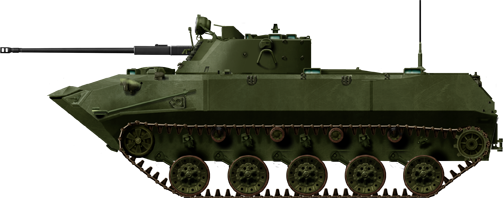
In Afghanistan, the Soviet Forces deployed both the BMP-1 and BMD-1, armed with the same low-pressure 2A28 "Grom" 76 mm cannon and 9S428 ATGM launcher capable to fire the 9M14/M/P "Malyutka" (NATO Sagger) and PKT MG. This was potent combination, yet they had been made for the Northwest European plains, not the ultra-rugger theater of operation they were committed. Ambushed from above, like in an urban theater, they fell easy prey to RPGs, and their armment was not able to elevate enough while their PKT was too light and their missile inadequate for this type of warfare. In short, the Soviet head of staff soon saw the need of a vehicle with a fast-firing light cannon. In 1981, the war has dragged on for two years already when units started to receive the new BMP-2 IFV, a welcome addition with its 30 mm 2A42 multi-purpose autocannon. It has the high elevation angle required, range, power and rate of fire to match insurgents.
In case they stumbled upon armoured vehicles, the BMP-1 pintle-mounted 9P135M-1 ATGM launcher had a semi-automatic control (SACLOS) firing accurately the 9M113/M "Konkurs" (Spandrel), 9M111 "Fagot" and other ATGMs, much more effective and reliable. Reports praising the BMP-2 in action trigerred the high command of Soviet airborne forces to ask for an airborne adaptation of the BMP-2, which became the BMD-2. The BMD-2 (Boyevaya Mashina Desanta, 2) thus became a Soviet airborne infantry fighting vehicle, to gain time, based heavily on the BMD-1, but with a new turret and hull modifications. It was deigned as a replacement of the BMD-1 but failed to replace it only in scale, as the USSR breadown prevented to continue the production. Ultimately NATO gave the BMD-2 the designation BMD M1981/1. Only around 2,500 or less has been estimated to be delivered by the Volgograd Tractor Plant until 1990. Production never restarted in Russia and instead the BMD-3 developement was completed and production started (a much larger vehicle, close to the BMP-3), and the BMD-4 in the 2000s.
Design
The design of the vehicle was given to Arkadyi Shabalin team at the Volgograd Tractor Plant. At first it was thought rightly the BMP-2 turret ould never fit on a BMP-1 hull. It was decided to design two vehicles, the first was urged to be sent to the airborne (IFV) by simply modifying the BMD-1/BMP-1 turret, with the same armament as in the BMP-2, and the whole fitted on a standard BMD-1 hull. The second vehicle was supposed to be much larger in order to fit the BMP-2 turret. This one will eveolved into the the BMD-3, just as USSR was about to collapse. In the end, the first variant of the BMD-1 was developed in 1983, incorporating the newly designed B-30 turret, but it was quickly found the hull needed some modernization as well. After tests with the 30 mm 2A42 multi-purpose autocannon and new 9P135M-1 ATGM launcher were performed, plus field trials, the BMD-2 entered production in 1985.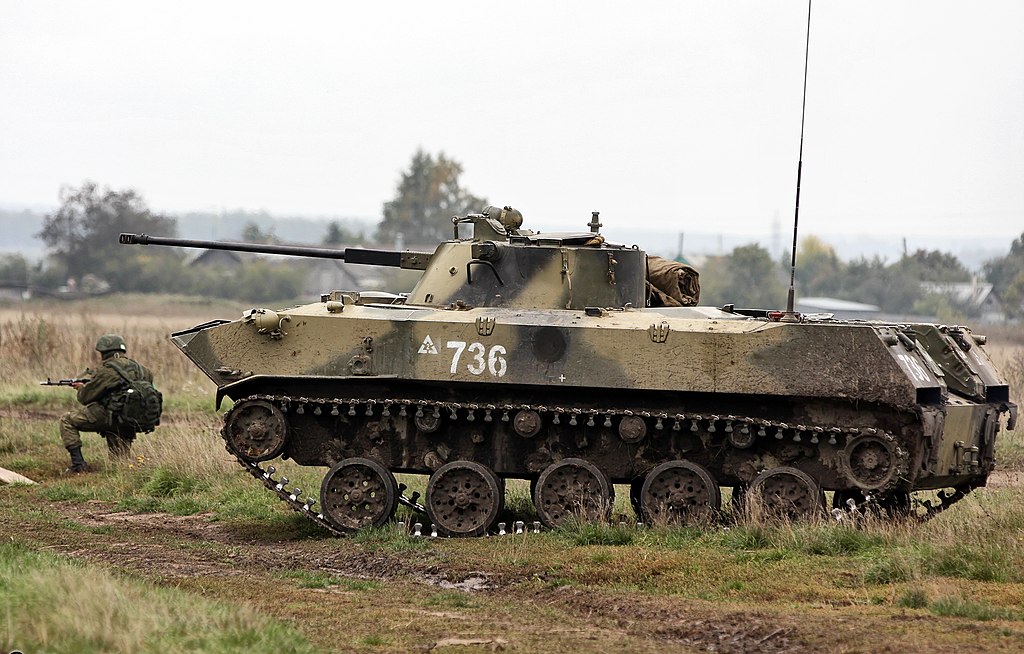
BMD-2 operating with the 106th Guards Airborne Division
Overall, the BMD-2 suffered from the same compromises made for the BMD-2, it is lacking protection and is extremely craped, in order to save weight, its sacrifices crew comfort. Being much smaller than the BMP-1 and BMP-2 it could only carry five infantrymen including the commander, its bow machine gunner and three soldiers seated just behind the turret. They exited via a trap above them, in front of the engine, having some protection from recesses around the engine ventilation grilles. The vehicle had three periscope vision blocks for the driver, three on the sides and rear for the fightiong compartment as well as three firing ports, on either side and rear. For communications, the BMD-3 shifted from the R-123 to the R-123M radio set. The commander no longer operated the left bow-mounted 7.62 mm PKT MG, removed after trials as distracting him. As customery for Soviet vehicle, the central driver persicope could be swapped for an IR vision block and a white searchlight is mounted in front of the turret. The latter is the B-30 modle, tailored for the vehicle, larger, roomier and heavily modified. It made the BMD-2 subtantially heavier than the BMD-1, from 8.3 to 11.5 tonnes.
The goal of the BMD-2 was to be carried by the same range of aircraft than the BMD-1. Like the former, it could be airlifted by the An-12, An-22, Il-76, An-124 airplanes and the Mi-6 and Mi-26 helicopters. Like the former, it was launched by using a parachute cradle, the the PRSM-915 developed for safe landing. The BMD-2 is lowered on a special pallet before takeoff, a drogue chute is released to drag the pallet sonwn to the opened ramp in flight. Once in flight, a single large main chute opens which triggers the deployment of four long rods hanging beneath the pallet. As soon as they touch the ground, a retrorocket fires to slow down the BMD at 6-7 m/s ensuring a softer landing. It was safe enough tha the vehicle carried directly the driver and gunner. As soon as the infantry was on the ground the vehicle was operational in a couple of minutes and could pick up the parachuted infantry nearby. Basically this system developed for the BMD-1 was used on the BMD-2, with some minor improvements, like the rocket rods, ground proximity detector and parachute. It was unique to USSR and still is used by Russia, faithful to its 1930s "deep battle concept" when airborne use was theorized.
Armament
The BMD-2 is armed with a stabilized 30 mm, 2A42 multi-purpose autocannon with 300 rounds in store, 180 AP and 120 HE, a remarkable achievement due to the size of the vehicle. It is completed by a coaxial 7.62 mm PKT light tank machine gun on the right hand side with 2,940 rounds in store. The main gun can be elevated or depressed between 75° and -5°, therefore a dual-purpose model usable against air targets, helped by its rate of fire. The turret roof accomodated a pintle-mounted 9P135M-1 ATGM launcher on the right hand side. It is given a semi-automatic control of the SACLOS type, to guide the 9M113 "Konkurs" (AT-5 Spandrel) anti-tank missile. However the same launched can also fire the 9M113M "Konkurs-M" (AT-5B Spandrel B), the 9M111 "Fagot" (AT-4 Spigot) and the 9M111-2 "Fagot" (AT-4B Spigot B). All are capable ATGMs able to pierce the equivalent of 200 mm of RHA at 60° or 400 mm flat. The "Fagot" has a radius ranging from 70 to 2,500 m (230–8,200 ft) and carries as High Explosive Anti-Tank (HEAT) warhead, 1.7 kg (3.7 lb). It starts at 80 m/s or 180 mph, 290 km/h exiting the launcher, then accelerates to 186 m/s or 420 mph and 670 km/h in flight speed. The 9M111M/AT-4C has a Tandem HEAT warhead capable of 600 mm RHA penetration. No spares are carried but externally.
Rear view of the BMD-2, 106th Guards Airborne Division
Powerplant
To fit in about the same hull, the BMD-2 carried the same, modernized engine, the 5D-20, 6-cylinder, 4-stroke, V-shaped, liquid cooled 15.9 liter diesel. Its output was 241 hp (180 kW) at 2,600 rpm and it produced a power/weight ratio of 21 hp/tonne (15.7 kW/tonne). The suspension and drivetrain was the same, with torsion bar and five light stamped roadwheels, four return rollers, rear drive sprockets and front idlers. Maximum road operational range was 450 km. For mobility, the BMD-1 is fully amphibious and can swim after switching on the two electric bilge pumps and erecting the two-parts trim vane plus switching the driver's standard periscope for a swimming periscope tht can be raised over the trim vane. Thanks to the suspension adjustable to be lower and be air-dropped its ground clearance range was between 100 mm to 450 mm. Top speed was 80 km/h on road, 40 km/h cross country and 10 km/h when swimming.
Airborne platoon run tests, 2018
Protection
Since the turret was about the same as the BMD-1, protection was very light. The hull was made of welded aluminium alloy (stronger than standard aluminium, with hardened face) with an armour thickness at best 7 mm (0.27 in) on the turret face and sides, 15 to 17 mm (0.6-0.7 in) on the front hull glacis, divided into a 78° upper slope and 50° for the lower. Armour was 10 mm (0.39 in) on the rest of the hull so the vehicle was just resistant to small arms fire and shrapnel as most APCs.Variants
- The BMD-2 (Ob'yekt 916) was the basic model, preserie and early production model.
- BMD-2K ('Komandirskaya') Command variant with an additional antennae and better radio set.
- BMD-2M: Modernized version developed in the 2000s: Turret smoke grenade launchers, 2 ATGM 9M133 "Kornet" launchers, new day/night sights.
Exports
The vehicle was reserved to the VDV, but after the Soviet collapse, it was passed on successors states, Russia (849 in active service, 1,500+ in storage 2013), and Ukraine (78 in the 2000s). Needless to say, the crews preferred by far the BMD-3, roomier, better protected and better armed. But the BMD-2 is small enough to ba carried by some helicopters, like the Mi-26.Active service
From 1985 to this day, the BMD-2 saw service mostly in Afghanistan (single test deployment in 1985-88), Chechnya, Ossetia, and Ukraine (Donbass conflict) apparently on the Ukrainian side, and captured by pro-russian militias. As o today, in Russia there were About 849 in active service, and more than 1,500 in storage as of 2013. Ukraine was the second largest operator with 63 in 1995, 78 in 2000 and 2005. According to warfare.be site, here were active deployment areas and units of the BMD-2:31st det (air assault) cdo bde Ulyanovsk Airborne Troops CENTER #73612. 1992-1993 transferred from Azerbajan. Ex- 104 airborne div (1998). Took part in Chechen war. 12.1994 fought for Groznyy, Group "East". 23.12.1994 got under RusAF airbombing: lost 5 BMD. 1 bn defended near Argun, 2 bn - Khankala. Commander Maj Gen Stas'kov was against assault of Groznyy, did not realize order and was faired. 01.1995 Group "South East": 900 pers, 3 tanks, 50 BMD, 17 BTR-D, 12 guns; fought for Komsomolskoe. 03.1995 Group "North", Shali, fought near Chernorech'e, blocked Argun jointly with 805 arty rgt. 05-06.1995 fought in mountains, Vedeno, Selmentauzen, Starie Atagi, Chishki, Duba-Yurt, Dachu-Borzoi. 11.1996 moved from Chechnya. Chechen campaign losses: 384 (84 killed/MIA). 10.1999-03.2000 91 bn Group "Center". 2000: 2196 pers., 86 BMD-2, 26 BMD-1, 57 BTR-D, 16 D-30, 24 BTR-RD, 19 BTR-ZD, 8 BMD-1KSh, 2 BMD-1R. 03.2004 tactical trainings at Seltsi. 09.2006 took part in "South Shield-2006" exercises. 08.2007 inspected by VDV CINC. 08.2007 took part in PEACE MISSION-2007 joint Russian-Sino exercises. 05.2008 10th anniversary. 08.2008 took part in war in South Ossetia. 2009: 2502 pers. 29.01.2010 descent exercises- 500 soldiers landed. 06-07.2010 secure Kant airbase during Kirgizia revolution. 02.2011 600 paratroopers jumpings from Il-76. 06.2011 one officer died during jumpings. 08.2012 visited President Putin and MoD minister.
108th cdo airborne rgt Novorossyysk 7th cdo (air assault) mountain div SOUTH #42091. 1602 pers., 39 BMD-2, 70 BMD-1, 35 BTR-D, 19 2s9 Nona, 7 BMD-1KSh, 9 BTR-RD, 13 BTR-ZD. 03.2007 military exercises jointly with Novorossyysk Naval base. 05.2007 constructed two new barracks for contract service soldiers. 08.2008 took part in war in South Osetia. 09.2008 60th anniversary. 04.2011 exercises- 1500 soldiers, 100 vehicles.
247th cdo rgt Stavropol 7th cdo (air assault) mountain div SOUTH #54801. Formed from 21 separate cdo bde. 1583 pers., 72 BMP-2, 36 BTR-80, 26 BTR-D, 18 Nona, 13 BTR-ZD, 9 BTR-RD. Ex-commander col Yury Em. 11.1999 -05.2000 took part in Chechen war: Group "East", Novogroznenskyy. Chechen campaign losses: 17? Killed/MIA. 07.2007 comd.staff exercises. 08.2008 took part in war in South Ossetia.
104th cdo rgt Pskov 76th cdo (air assault) div WEST Operations: 1989-1990 Tbilisi, Osh, Fergana, Pridnestrovie, 1992-1993 South Ossetia. 1554 pers., 31 BMD-3, 20 BMD-2, 51 BMD-1, 34 BRT-D, 12 Nona, 13 BTR-ZD, 6 BTR-RD, 6 BMD-1KSh. 10.1999 took part in Chechen war, Zone "East" 11.1999 fought for Gudermes. 29.02-1.03.2000 during heroic defence in Chechnya 6th company (commander bn lt.col Evtyukhin) was destroyed, killed 400+ terrorists, lost 83 (of total 86) persons (13 officers) near Ulus-Kert. 07.2003- 02.2004 two bns in Checnya: 220 combat operations, killed 30 terrorists incl 3 field commanders, destroyed 25 arms warehouses. 09.2006 comd staff exercises. 08.2008 cdo bn took part in war in South Ossetia. Losses: 3?killed. 05.2010 take part in parade in Minsk devoted to V-day.
234th airborne rgt Pskov 76th cdo (air assault) div WEST 1601 pers., 98 BMD-1, 32 BTR-D, 18 Nona, 12 BTR-ZD, 6 BTR-RD, 5 BMD-1KSh. 09.2006 comd staff exercises jointly with 8th belirussian cdo bn. 08.2007 landing trainings. 08.2008 took part in war in South Ossetia.
217th airborne rgt Ivanovo 98th airborne div WEST #62295. 2000: 1555 pers., 109 BMD-1, 32 BTR-D, 18 Nona, 11 BTR-ZD, 6 BTR-RD, 7 BMD-1KSh, 1 BMD-1R. 06.2007 landing trainings. 10.2007 celebrated its 49th anniversary. 08.2008 took part in war in South Ossetia. Losses: 1?killed. 09.2009 ZAPAD-2009 exercises.
331st airborne rgt Kostroma 98th airborne div WEST #71211. 2000: 1555 pers., 102 BMD-1, 33 BTR-D, 18 Nona, 15 BTR-ZD, 6 BTR-RD, 5 BMD-1KSh, 1 BMD-1R. Commander: col Nikolai Mayorov, awarded by President Putin as Hero of Russia in 2000. 10.1999-03.2000 took part in Chechen war, Zone "East". 09.05.2006 took part in V-day parade in Moscow.06.2007 awarded by Red Pennant by Pres Putin. 08.2008 took part in war in South Ossetia. 05.2010 take part in V-day parade in Moscow.
137th airborne rgt Ryazan 106th airborne div WEST #41450. Formed 1948. 1561 pers., BMD-4, 32 BMD-3, 70 BMD-2, 10 BMD-1, 38 BTR-D, 19 Nona, 13 BTR-ZD, 6 BTR-RD, 7 BMD-1KSh, 1 BMD-1R. 02.2006 descent bn exersises. 09.2006 comd staff exercises. 04.2008 ceremony of new pennant. 10.2008 60th anniversary. 2009: to 98 airborne div, turned back
Src/read More
The BMD-2 on WikipediaThe BMD-2 on https://www.armyrecognition.com
The BMD-2 on aw.my
The BMD-2 on army-technology.com
The BMD-2 on on globalscurity.org
The BMD-2 on warfare.be (archive)
The BMD-2 on mil.today
BMD-2 specifications | |
| Dimensions (L-w-h) | 7.85 m x 2.94 m x 2.45 m |
| Total weight, battle ready | 11.5 Tonnes (? lbs) |
| Crew | 6 (Driver, Gunner, Cdr, Bow MG gunner and 2 infantry) |
| Propulsion | 5D-20 V6 diesel 241 hp (180 kW) P/w 32.1 hp/t |
| Suspensions | Hydraulic independent torsion-bar |
| Speed (road/offroad/water) | 80/45/10 kph (49/28/6 mph) |
| Range (road/water) | 600/116 km (372/71 mi) |
| Armament | 30 mm 2A42, 9P135M-1 ATGM, 7.62 mm PKT bow & coaxial LMG |
| Armor | 7 to 15 mm alum. alloy |
| Total production | Circa 2,500 |

Barebone BMD-2 early production, note the BMD-1 roadwheels
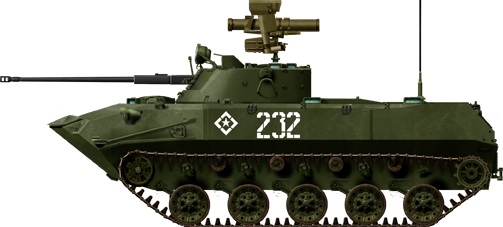
Early BMD-2 of the VDV in 1990
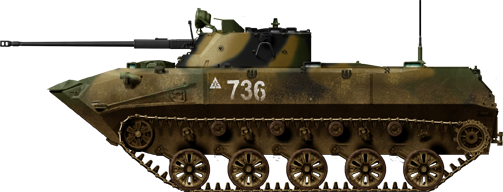
Camouflaged BMD-2 of the VDV, 1994
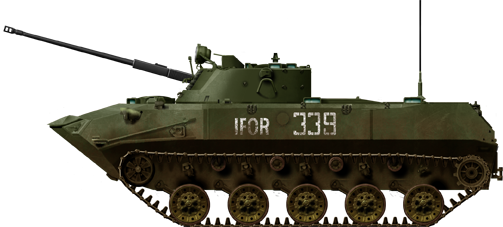
BMD-2 in Bosnia with IFOR, winter 1993-94
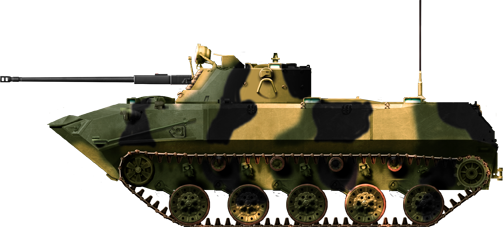
Unidentified camouflaged BMD-2 of the VDV
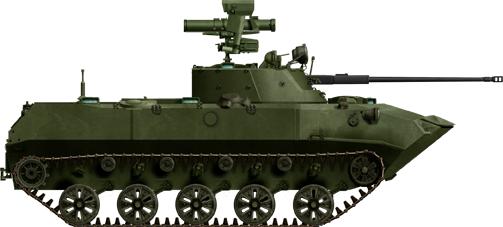
BMD-2 in tests

BMD-2 of the Ukrainian Army during a 2014 parade in Kiev. Note the "digital" pattern camouflage
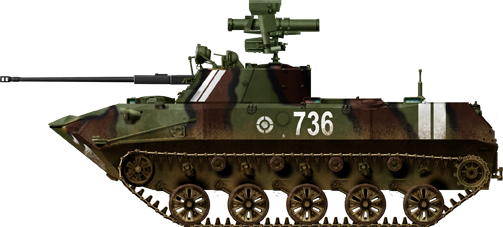
Ukrainian BMD-2 during the Ukrainian crisis, 2018
Video: BMD-2 parachute rocket montage
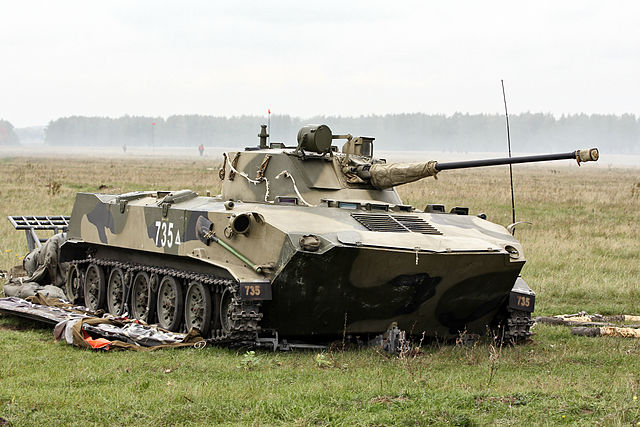
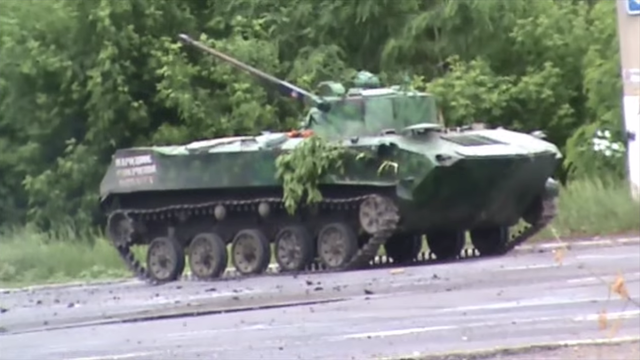

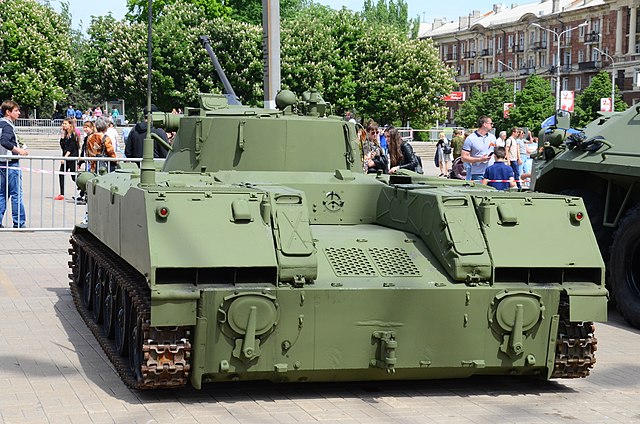


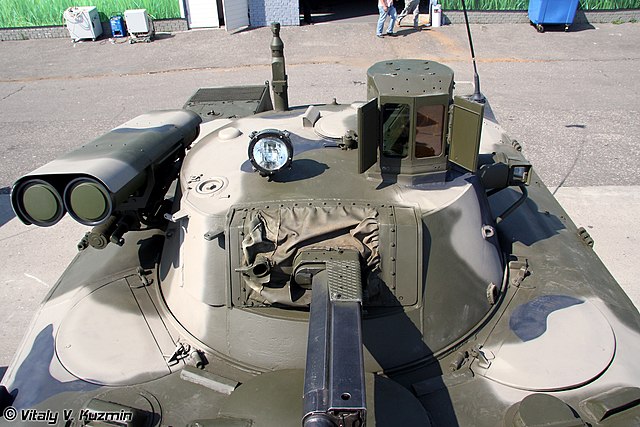



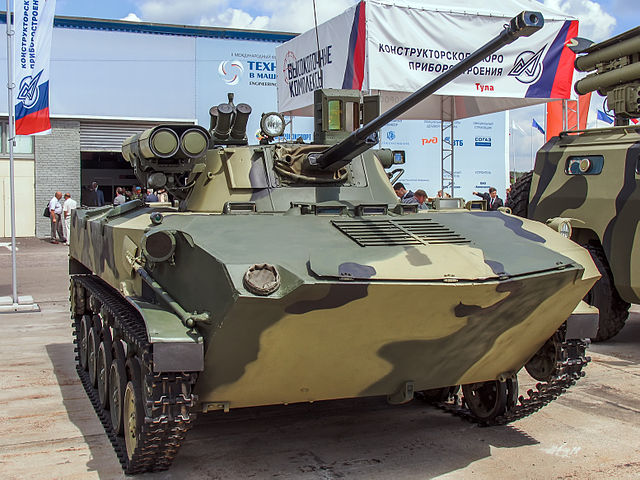
More

Cold War Tanks


































Cold war tanks posters

Cold War Main Battle Tanks

Cold War Soviet Army

